|
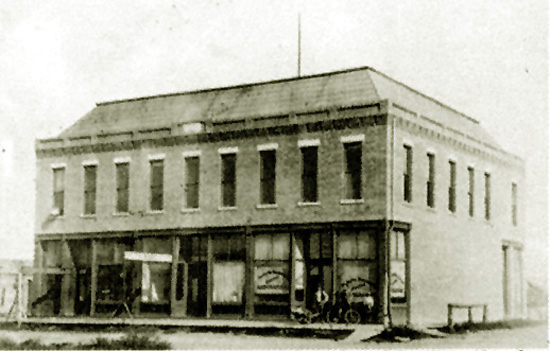
Casper Odd Fellows Hall.
By the end of 1896, casper was the proud possessor of a new Odd Fellows Hall. The building, at the
time, was the largest masonry building in town. On the ground floor were three stores and upstairs was
a 2,211 square foot public hall used for dances, political meetings and some of the early churches. In addition was a
lodge room measuring 67 feet long by 33 feet wide used by the Odd Fellows, the Masons, and other fraternal orders.
The first event in the new hall even before its final completion was a Christmas night Dance which lasted until
5:00 a.m. Three days later the ladies' social club sponsored another dance. It broke up early, 4:00 a.m.
By 1900, the town had electic lighting and two years later telephones.
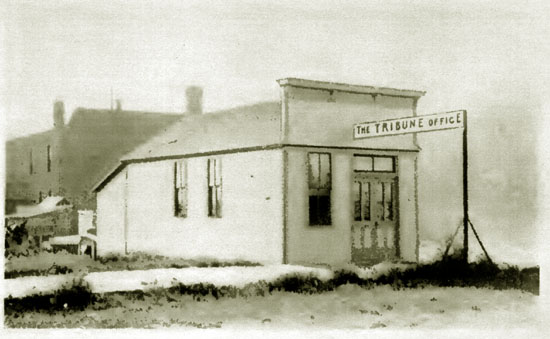
Natrona Tribune Building, Casper.
The first editor of the Tribune was J. Enos Waite who had previously edited the
Bessemer Journal. On June 1, 1897 Alfred Mokler assumed ownership of the paper. The Tribune was a Republican paper. Its competitor, the Wyoming Derrick was
Democratic.
On March 28, 1902, there was more exciement at the jail. In November 1901, Charles F. Woodard, a sheepherder from the Rattlesnake
Hills west of Casper, his brother Clarence and Charles' wife Bertha
were arrested for Grand Larceny for stealing household furniture and clothng from Sam Hanes. The charges against Bertha
were dropped. Charles and Clarence could not
make bond and was held in the jail. On December 30, Charles, Clarence and two other inmates left the security of the jail by sawing through the
bars. Sheriff W. C. Ricker with a posse proceeded 75 miles west to Woodard's Ranch. Woodard was not there. He and his brother had not yet arrived, they being on foot.
When Woodward arrived home, he observed the posse's horses and determined to steal one of the horses. Within the house, the Sheriff heard a noise from
the barn. When the sheriff approached the barn, a shot from Woodard killed the sheriff. Woodard stole forty-five dollars, a six-shooter, and a cartridge belt from the
sheriff's body and and departed on a stolen horse to northern Wyoming. Sheriff Ricker was very popular. He was chief of the fire department. Additionally,
he was Noble Grand of the Odd Fellows Lodge,
a member of the Masons and the Eastern Star and was to be initiated the following week into the
Rebekahs. The Board of County Commissioners offered an award for the capture of Woodard. the funeral at the Odd Fellows Hall was the largest Casper
had seen to that date. Symbols of Masonry, Odd Fellowship, and the Fire Department were placed upon his
casket as well as sprigs of evergreen emblematic of eternal life.
It took Woodard ten days to get to Arvada, Wyoming, on the stolen horse. In Arvada, he abandoned the horse and
hopped a freight to Billings and from there he proceeded to Laurel, Montana, where he obtained a job under a
fictitious name. Unfortunately, his new employer recognized him.
Following his capture, Woodard was hardly recognizable. His head was cut open in three places, both eyes were blackened, and his face
was badly bruised. The train from Montana arrived in Casper at 11:00 p.m. Not withstanding the lateness of the hour a large crowd
had gathered to welcome him home. the sherif was able with the help of about 30 citizens able to
escort Woodard to the jail. In short order, trial was held, he was convicted, and sentenced to death. In pronouncing sentence, Judge
charles W. Bramel promised Woodard that there was no "hope of pardon or executive clemency." The punishment of death was by the "law which was written by the
pen of inspriation under the dictation of the unering wisdom of the Most High" The punishment was, according to
Judge Bramel, prescribed "by God himself."
Woodard appealed. Upon the filing of the appeal, the
Supreme Court granted a stay. As prophesized by Judge Bramel, the stay did not save the fate
forecast by the Judge.
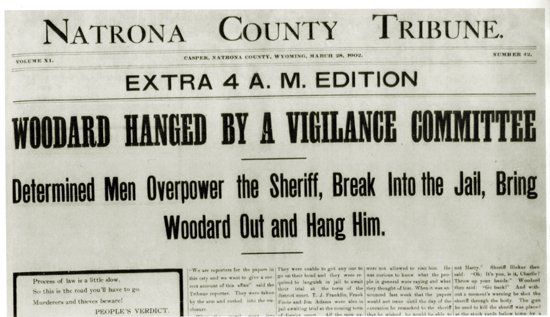
Headline, Natrona County Tribune, March 28, 1902.
At 12:40 a.m., March 28, 1902, the day previously set by Judge Bramel for the hanging,
a group of hooded men knocked on the door of the jail and indicated that they had
a prisoner to be placed in the jail. When the sheriff opened the door, he was overpowered, boundk gagged, and the cell keys taken from him.
While two men held the sheriff under guard, the remaining men seized Woodard. He was taken half naked out to the stockade which had been constructed
behind the jail and the awaiting gallows. There reporters for the Tribune and the Derrick had already been admitted to the stockade and apparently
accompanied the men to the jail. When taken up the stairs to the platform and the noose placed about his neck, Woodard begged:
"Boys, let me kneel down and pray for you; I want to pray for all of you!
"These are the last words to my blessed little wife: Tell my
dear little wife that I loved her dearly. Won't you tell her that, boys?
I pray that you have the papers print this. O, God, forgive me for my
sins. I pray for myself and I pray for Charley Ricker. I never had
any grudge against him in God's world.
" Don't choke me' hoys. For God's sake, you are choking me. Don't choke me to death.
O, God, have mercy on me. God have mercy on my soul and I pray for my blessed little wife.
Don't choke ne to death, boys! You are choking me. Please don't choke me. I did not shoot Charley Ricker
on purpose. Lord, have mercy on me and ny dear little wife."
Moker, in his History of Natrona County, continued with a description of the hanging similar to that published in a
special edition 4:00 a.m. edition of the
Tribune:
With the rope tightly drawn about his neck he was then lifted on the trap, hut he gave a
spring off from it before the lever could be pulled and in making the jump,
he slipped and fell. He was then picked up by several of the men and thrown over the
railing on the north side of the gallows. When the rope was drawn to full tension,
there were a few fearful struggles and nervous twitches of the body tangling in the air,
and two of the men caught hold of his feet and gave them several hard jerks. They then drew the body toward the north and letting loose the dangling and almost lifeless form of :hc wretched man,
it swung back and struck the framework of the gallows.
They then all stood hack and watched the writhing form. A gurgling sound came forth, which was the
most sickening noise human being ever heard. He was choking to death.
Everybody was silent for a moment and the gurgling sound kept getting fainter and fainter, until life was extinct. History of
Natrona County, pp 287-288.
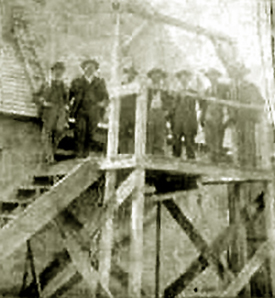 . . . . . .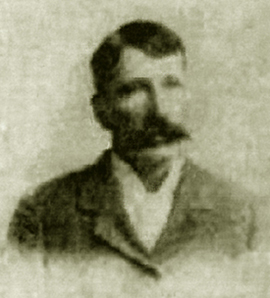
Left: Vigilence Committee, March 28, 1903:
Right: Charles F. Woodard
In less than an hour, the body had been cut down and taken to the City Hall, by then located on South Center Street opposite where the
Consolidated Royalty Building is now located, and a coroner's jury was appointed to meet the next norming at the city hall. It, of
course, determined that the deed was done by persons unknown. At the City Hall pieces of the rope left around Woodard's neck were cut off and cut into pieces to
be distributed as grusome suveniers.
The Tribune account differs only in a few details. A reference to "terrible contortions" has been removed by Mokler from the original
Tribune story. The account indicates that in attendance were a reporter for
the Tribune and a "special reporter" for the Derrick were present. The Derrick
account explains the presence of the reporters that they had heard 'rumors" and decided to check out the jail.
The presence of hooded men aroused their suspicions. They were admitted to the stockade and, apparently,
from the direct quotations of conversations in the jail, the jail. A by-line was never used in either the Derrick or
Tribune account. Both papers appeared to have approved or at the least condoned the action. The April 3 edition of the
Tribune headlined a story as "A Good Job Well Done." Judge
Bramel was quoted as excusing the hanging. It was, he indicaed, the
"voice of God, in as in other things that go to make up the sum of life, and the people can not be fooled."
Governor Chatterton was less sanquine. He wired the county prosecuting attorney requiring that he ascertain the names of the men
of the vigilence committee and vigorously prosecute them for "debauching the state's fair name." The Governor's directive was, like the
Supreme Court's stay, ignored.
No investigation was made. Undoubedly the names of at least some who participated. A reading of the accounts in the
two newspapers would suggest that Mokler himself was well aware of those participating and, indeed, may have been served in the dual
role of "reporter" and "special reporter." To admit to such, however, would have been an admission to a charge of murder.
In Butch Cassidy "wannabe" William T. Phillips' The Bandit Invincible, several mentions are made of a "Woodward" who assisted the
Wild Bunch in the Belle Fourche, Tipton, and Winnemucca Robberies. Larry Pointer in his In Search of Butch Cassidy speculates that Woodward may have
been one of the Woodard Brothers. Such, however, is mere speculation. There is no evidence, other than similarity of the
surname, to support the supposition. It is, in any event, unlikely, that it would have been Charles. He was newly married at the time of the
Winnemucca robbery.
At the end of his term, Judge Bramel went back into the private practice of law. In October 1907, a disgruntled former client who
had been brought to financial ruin murdered Judge Bramel in his office in Laramie City. For details see
Laramie.
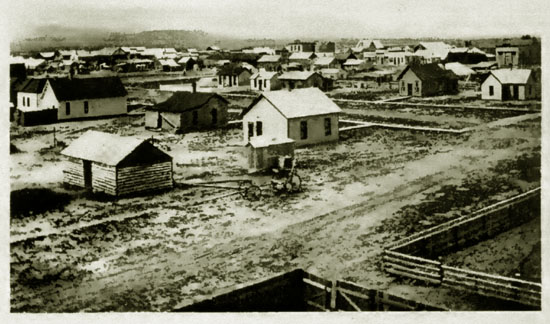
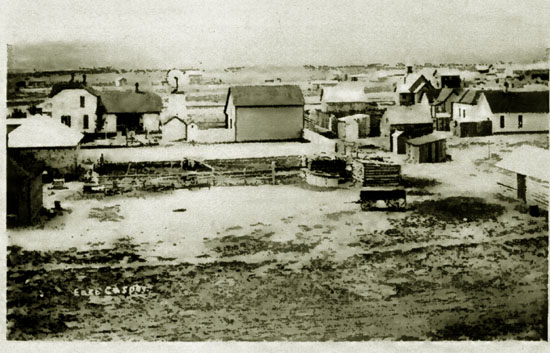
Residential Sections, Casper, 1894

Casper, undated
Casper Photos continued on next page.
|